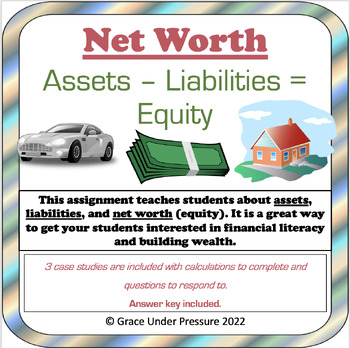Financial Literacy: Net Worth, Assets, Liabilities, and Equity: Personal Finance
- PDF
- Easel Activity
Also included in
- Everything you need to teach your high school students about all aspects of personal finance and financial literacy in fun and visually-appealing lessons, activities, and games. These personal finance worksheets and activities cover important skills such as income taxes and tax refunds, budgeting, cPrice $18.75Original Price $26.75Save $8.00
Description
This engaging assignment teaches high school students about assets, liabilities, and net worth (equity). It is a great way to get your students interested in personal finance, financial literacy, and building wealth.
First, give students the one-page handout to teach the definitions and examples of assets and liabilities, along with the formula for calculating equity (net worth).
Then, 3 real world case studies are included with calculations to complete and questions to respond to. Students have to total each person's assets and liabilities and calculate their net worth. They can make suggestions about financial habits that person might change.
Students can start to see how high income does not always lead to high net worth if the person spends more than they make and has debt. On the other hand, someone with a lower income can have a high net worth if they live a frugal lifestyle and save money in investments or home equity. Just because someone "looks" rich, doesn't mean that they are! This could stimulate some interesting class discussions about money management and what truly brings people happiness.
Answer key included.







